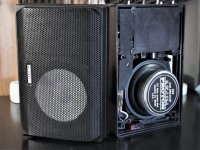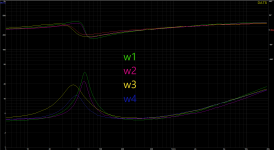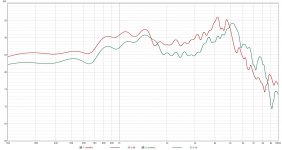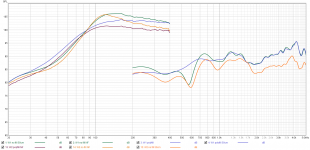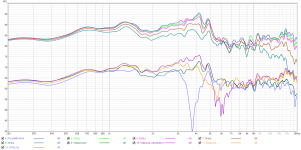Do magnets age? Proton 285 for home use.
Hi.
Friend gave me these old Proton 285 2-way car speaker component units. (Pic1) I think car audio days for these have passed, so idea is just to make them a sealed box for home use, that idea became because I measured one of the woofers (w3) and the parameters seemed such that they could work in 8+ litre sealed box. I have 4 woofers but parts for 2 whole units. Problem is that after measuring all the woofers there seems to be quite much difference in driver parameters.
So, the question is, are these differences caused by. 1.My measurements. 2. Factory tolerances (these are made probably mid -90s) 3. Due the ageing.
Here are the measurements:
T/S Parameters taken using DATS v2 (I used added mass and test box method and got similar results.) Impedance curves in a Pic2
w1
Fs 61.2Hz Qts 0.56 Qes 0.62 Qms 5.54
w2
Fs 58.5Hz Qts 0.84 Qes 1.0 Qms 5.1
w3
Fs 42.4Hz Qts 0.43 Qes 0.53 Qms 2.1
w4
Fs 46.4Hz Qts 0.77 Qes 1.13 Qms 2.4
All were similar with Re around 3.4ohms, Le 0.33-0.46 and Mms 7.5-8.3g
There is slight differences between looks with these two pairs and also with parameters, w1 and w2 might be older and have higher fs. Because impedance curves seem more alike with w1 and w2, I thought to use them but then there is that Qes and also Bl difference (w1 Bl4 w2 3.4) and that "sensitivity" difference shows also in a modelling.
Pic3 is w1 and w2 measured in a 8.1l test box, 50cm away with same 1.23V drive level in a room but IR windowed.
That sensitivity difference of about 3dB and Qes difference worries me, can this be because the age. Has two of these woofers lost magnetism or are there something else going on and can anything be done about that?
Thanks for any ideas, I have been lurking some time on this forum and gotten much great information but now I'm posting for the first time.
Hi.
Friend gave me these old Proton 285 2-way car speaker component units. (Pic1) I think car audio days for these have passed, so idea is just to make them a sealed box for home use, that idea became because I measured one of the woofers (w3) and the parameters seemed such that they could work in 8+ litre sealed box. I have 4 woofers but parts for 2 whole units. Problem is that after measuring all the woofers there seems to be quite much difference in driver parameters.
So, the question is, are these differences caused by. 1.My measurements. 2. Factory tolerances (these are made probably mid -90s) 3. Due the ageing.
Here are the measurements:
T/S Parameters taken using DATS v2 (I used added mass and test box method and got similar results.) Impedance curves in a Pic2
w1
Fs 61.2Hz Qts 0.56 Qes 0.62 Qms 5.54
w2
Fs 58.5Hz Qts 0.84 Qes 1.0 Qms 5.1
w3
Fs 42.4Hz Qts 0.43 Qes 0.53 Qms 2.1
w4
Fs 46.4Hz Qts 0.77 Qes 1.13 Qms 2.4
All were similar with Re around 3.4ohms, Le 0.33-0.46 and Mms 7.5-8.3g
There is slight differences between looks with these two pairs and also with parameters, w1 and w2 might be older and have higher fs. Because impedance curves seem more alike with w1 and w2, I thought to use them but then there is that Qes and also Bl difference (w1 Bl4 w2 3.4) and that "sensitivity" difference shows also in a modelling.
Pic3 is w1 and w2 measured in a 8.1l test box, 50cm away with same 1.23V drive level in a room but IR windowed.
That sensitivity difference of about 3dB and Qes difference worries me, can this be because the age. Has two of these woofers lost magnetism or are there something else going on and can anything be done about that?
Thanks for any ideas, I have been lurking some time on this forum and gotten much great information but now I'm posting for the first time.
Attachments
Last edited:
More testing.
I made a test box that is about 20cm in depth and width and height were same as this unit frame is. Volume ended up being 4.7 litres. That would be nice compact size, but I probably will make final cabins bit bigger. I measured units 1 and 2 in this test box without any fill and also with full of polyfill. (attachment 1)
Woofer 1 response with box full of polyfill looks ok for my use. There are some resonances at responses where there was no fill, but those seem to go away with polyfill.
I also took unit 1 and did some gated measurements in different angles (attachment 2). Horizontal measurements are mic at woofer axis. Vertical results are offset -20dB, those are also measured from woofer axis and there at 10deg up at woofer axis mic is at tweeter level and there is a dip at 6khz.
Here is also video about unboxing and testing these Proton 285 speakers.
I made a test box that is about 20cm in depth and width and height were same as this unit frame is. Volume ended up being 4.7 litres. That would be nice compact size, but I probably will make final cabins bit bigger. I measured units 1 and 2 in this test box without any fill and also with full of polyfill. (attachment 1)
Woofer 1 response with box full of polyfill looks ok for my use. There are some resonances at responses where there was no fill, but those seem to go away with polyfill.
I also took unit 1 and did some gated measurements in different angles (attachment 2). Horizontal measurements are mic at woofer axis. Vertical results are offset -20dB, those are also measured from woofer axis and there at 10deg up at woofer axis mic is at tweeter level and there is a dip at 6khz.
Here is also video about unboxing and testing these Proton 285 speakers.
